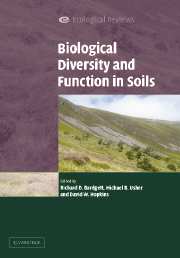Book contents
- Frontmatter
- Contents
- List of contributors
- Preface
- Acknowledgements
- PART I Introduction
- 1 Developing new perspectives from advances in soil biodiversity research
- PART II The soil environment
- PART III Patterns and drivers of soil biodiversity
- PART IV Consequences of soil biodiversity
- PART V Applications of soil biodiversity
- PART VI Conclusion
- Index
- References
1 - Developing new perspectives from advances in soil biodiversity research
Published online by Cambridge University Press: 17 September 2009
- Frontmatter
- Contents
- List of contributors
- Preface
- Acknowledgements
- PART I Introduction
- 1 Developing new perspectives from advances in soil biodiversity research
- PART II The soil environment
- PART III Patterns and drivers of soil biodiversity
- PART IV Consequences of soil biodiversity
- PART V Applications of soil biodiversity
- PART VI Conclusion
- Index
- References
Summary
SUMMARY
We use a historical context to examine the accomplishments of soil biodiversity and ecosystem research. These accomplishments provide a framework for future research, for enhancing and driving ecological theory, and for incorporating knowledge into sustainable management of soils and ecosystems.
A soil ecologist's view of the world differs from that of a terrestrial ecologist who focuses research primarily on above-ground organisms. We offer ‘ten tenets of soil ecology’ that illustrate the perspectives of a soil ecologist.
Challenges for the future are many and never has research in soil ecology been more exciting or more relevant. We highlight our view of ‘challenges in soil ecology’, in the hope of intensifying interactions among ecologists and other scientists, and stimulating the integration of soils research into the science of terrestrial ecology.
We conclude with the vision that healthy soils are the basis of global sustainability. As scientists, we cannot achieve our future goals of ecological sustainability without placing emphasis on the role of soil in terrestrial ecology.
Introduction
Despite the visionary appeals of an earlier generation of soil scientists, soil biologists and others (Jacks & Whyte 1939; Hyams 1952), above-ground ecologists have hitherto shown insufficient awareness of the significance and fragility of soils and the need to understand how life in soils relates to sustaining our global environment. However, many scientists, including microbial ecologists, atmospheric scientists, biogeochemists and agronomists, as well as economists and policy makers, are now starting to take heed of the multiple issues involving soils and their biota, on both local and global scales.
- Type
- Chapter
- Information
- Biological Diversity and Function in Soils , pp. 3 - 28Publisher: Cambridge University PressPrint publication year: 2005
References
- 16
- Cited by

